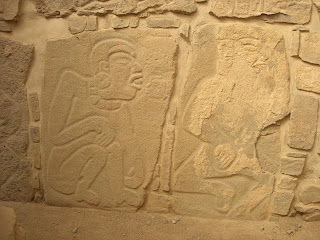 |
 |
| The name Monte Alban was given to the area in the 16th Century after the Spanish landowner's surname "Montalvan" |
 |
| Bickmore's looking for a tennis court, but in Monte Alban ballgames of a different kind were played. Figurines and a stone monument discovered here were radiocarbon- dated as far back as 1250-1150 BC. The games were played with a hard rubber ball, weighting 6 to 9 pounds. If you would like to know more http://www.monte-alban.com/ballgame.htm |
 |
| Over 4000 years ago, a village-dwelling people, probably from the Olmec colonies moved into the Oaxaca valleys. The time period of the Jaredites |
 |
| Then, around 500 BC (1500 years later) a new people the zapotecans moved into the region |
 |
| Sculptures reflect contact with the Maya, and architectural ideas were borrowed from Teotihuacan around 300 AD |
 |
| The Zapotecans (500 BC) began the monumental task of leveling the top of this 1,600 meter high mountain |
 |
| By the beginning of the 13th century, the Mixtec expanded their territory and reoccupied the Territory. The Mixtec left many tombs with famous treasures. |
 |
| It also had two eras of decline. The 1st around 200 AD and the 2nd 800 AD. Many human sacrafices were offered during this time. (Mormon 4:21) |
 |
| Monte Alban has a maze of subterranean passage ways, rooms, drainage and water storage systems Our friend Santigo as a child has been in all of them. |
 | ||
| Human Sacrifices were preformed here A.D. 363 (B of M)
|
 |
| All of the city has not yet been unearthed. You are looking at more dwellings, tombs and more treasures of Monte Alban to be discovered |
 |
| Sun Dial |








No comments:
Post a Comment